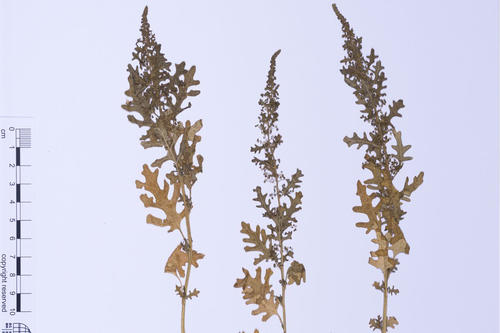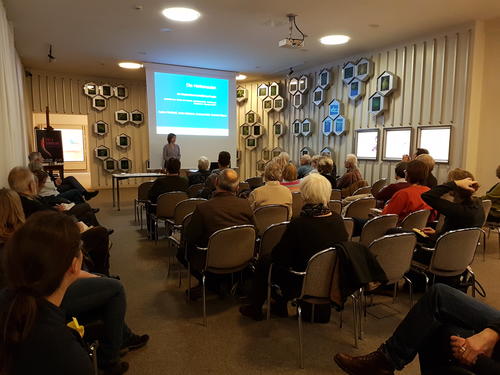Herbonauts on a Deciphering Mission
Citizens are invited to contribute to the project “Die Herbonauten,” harnessing their knowledge to tap into the herbarium of the Berlin Botanic Garden and Botanical Museum in scientific terms.
Feb 21, 2018
Herbarium specimens document the wealth of different forms found in nature. The preserved plants store evidence of insecticides used in the 1970s, the Chernobyl nuclear disaster in the 1980s, and particulate matter found in the present day.
Image Credit: Herbar, Botanischer Garten und Botanisches Museum Berlin
Thanks to their special knowledge of scripts or sheer curiosity, participants in the “Herbonauten” workshop aim to contribute to the scientific discovery of the world.
Image Credit: G. Hohlstein, Botanischer Garten und Botanisches Museum Berlin
Clad in knickerbockers, botanical specimen containers in hand, the botanists of the 19th century walked along, bent over, with their eyes trained on the turf. Flowering plants, mosses, fungi, algae, ferns, and lichens have been collected in Dahlem since 1819 – and on a grand scale, at that.
The herbarium collection at the Botanic Garden and Botanical Museum (BGBM) of Freie Universität Berlin is now home to a whopping 3.7 million objects, occupying hundreds of meters of shelf space. They include treasures such as materials from Alexander von Humboldt’s expedition to South America and type specimens of newly discovered species. This makes the Herbarium Berolinensethe largest archive of plants in Germany. It is also among the largest in the world.
The collections of pressed, dried plants, glued to sheets of paper, are extremely important to researchers. They provide information on the presence and prevalence of certain species in a certain region at a certain time, offering a record of how the flora and the climate have changed. Herbaria make it possible to see how species have declined and foreign ones have invaded. This makes them the basis for preparing distribution maps, which are also vital to nature conservation.
To this day, however, the majority of herbarium specimens only exist on paper. As a result, thousands of paper specimens must be sent to international research institutions every year, a laborious and time-consuming process that is also costly and risky. Now, the countless objects, some of them centuries old, are to be captured in digital form. It is a huge project – and one that is being undertaken with support from the populace.
Quite an Undertaking
Digitization offers a number of advantages. The Internet facilitates research work and dialogue among scientists and researchers. The project is also using modern methods to open up the herbarium for future researchers, enabling new research questions. By way of a database, for example, specimens can be sorted quickly according to various criteria, such as plant species, country of origin, date found, or the name of the collector, regardless of how they are physically sorted in the herbarium itself.
Digitizing the existing collection is quite an undertaking. In particular, the process of manually transferring the information contained in labels to an electronic database is hugely time-consuming. “The labels were collected over several centuries,” says Agnes Kirchhoff, of the Biodiversity Informatics research group at the Botanic Garden, “and they look it.” Some were written with a quill pen, others by typewriter; some were written in the old-style German script known as Sütterlin, which has fallen into disuse since the mid-20th century, and others in Latin. These handwritten items cannot be read out using technical methods; human pattern recognition skills are far superior.
To handle this massive task, the Botanic Garden has launched a project titled “Die Herbonauten.” Members of the public are invited to participate online; the project website, www.herbonauten.de, went live in March 2016. The project is modeled on a similar one called “Les Herbonauts,” initiated by the French National Museum of Natural History (Muséum national d’Histoire naturelle), in Paris, which also supplied the software, later adapted for use on the current project.
“Herbonauts” in Training
In search of volunteer helpers, the BGBM issued an invitation to an introductory workshop in early December. Some three dozen “herbonaut” hopefuls attended, gathering at the Botanical Museum’s Blütensaal (“Flower Room”). The group included a professional linguist, a retired biology teacher, and a retired chemist. Botany enthusiasts encountered computer newbies in the process. Some had special knowledge of 19th-century manuscripts, while others had come in hopes of marking obscure places on a map. During the workshop, they learned what herbonautical research is like.
The herbonauts can read important information from the labels affixed to the specimens and enter it in the online form. The data to be collected are strictly limited: country of origin, region, date found, the names of the collector and identifier and, for advanced researchers, the GPS coordinates. Many of these pieces of information are not simply written down, so tracking them down requires some detective work. To be able to enter information that requires a higher degree of precision, the herbonauts have to pass a quiz before advancing to the next level. A ranking shows who has decoded the most labels, and a comments section offers space for the botany detectives to engage in discussion.
Tapping into Locals’ Knowledge
One example chosen by Kirchhoff at random as an illustration features a capriciously curving script that is open to interpretation: Was the place where it was found “Łeba,” a town in Poland, or might the Baltic Sea resort town of “Laboe,” in the German state of Schleswig-Holstein, have been meant? Similar differences of opinion are unavoidable online, too. With this in mind, each specimen is viewed by at least two herbonauts. If their interpretations differ, researchers from the BGBM review the case. “This means volunteers don’t have to worry about making mistakes,” Kirchhoff explains.
So what makes this new form of “citizen science” different from how citizens used to participate in science and research? “The technical element,” Kirchhoff answers. “The Internet makes it much easier for citizen scientists and researchers to connect with each other.” It is also possible for people to participate if they are no longer able to go into the field, but would still like to contribute from home. “The Internet is home to vibrant research activity spurred by a wealth of idealism.”
Citizen scientists work collectively to decipher an amount of data that the full-time researchers at the Botanic Garden could not handle “in a hundred years,” Kirchhoff explains. “We rely on the contributions of engaged citizens,” she says. “The volunteers lay the groundwork for our research work.”
Through digitization, the Botanic Garden in Dahlem is ensuring that data on biodiversity are available worldwide. The original specimens will still be preserved, however. They are essential to possible later molecular studies of plant organisms.
Further Information
Agnes Kirchhoff, Research Assistant, Biodiversity Informatics Projects, Botanischer Garten und Botanisches Museum Berlin-Dahlem, Tel.: +49 30 838 50167, Email: a.kirchhoff@bgbm.org


